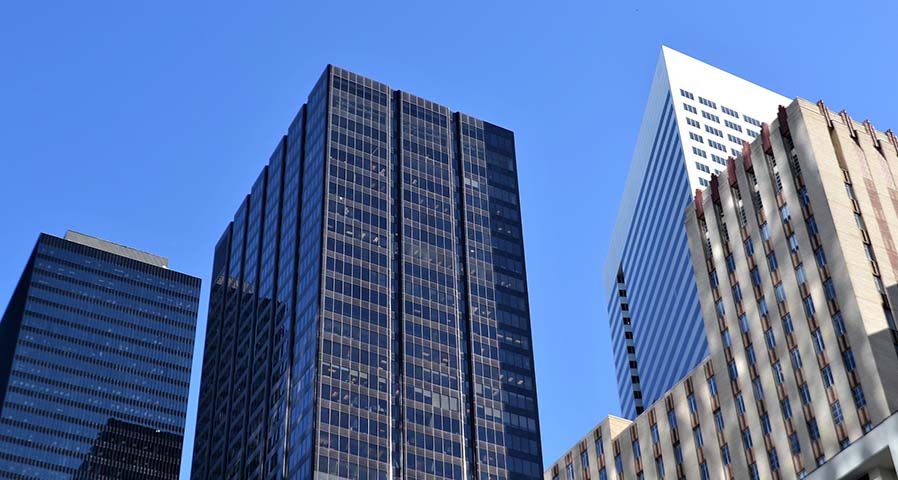Daylighting Controls & Daylight Savings: Optimizing Natural Light Through the…
Studies have shown that natural lighting has proven to improve workplaces by helping employees be more…

This was originally published February 23, 2022, and updated on July 8, 2025.
Advanced lighting control systems provide property managers with the tools they need to optimize their building, reduce energy consumption, and improve light quality for tenants and employees. Modern lighting control systems operate in tiers, meaning property managers can decide how precise they want their controls. They range from individual fixtures to standalone zones and full building controls, all the way to a whole enterprise spanning multiple facilities.
This lower tier controls lighting at the fixture level. Each light functions independently, often with built-in sensors that respond to occupancy or ambient light. This tier is ideal for small offices, restrooms, storage areas, or other spaces where lighting needs are straightforward.
Controls at this tier typically include:
Installation for this tier is simple and cost-effective because they don’t require networking throughout the rest of the building.
The second tier manages lighting controls for multiple fixtures and groups them into a zone, and is typically used for rooms, floor sections, or departments within an office. While still not networked to a centralized platform, these zones can be programmed via wall-mounted controls, mobile apps, or tablets, allowing for localized automation, scheduling, and basic customization.
Standalone zone systems are ideal for spaces that don’t require whole-building oversight but still benefit from more advanced functionality than individual fixtures alone. They are commonly used in conference rooms, offices, classrooms, retail sections, or any space that requires flexible lighting for different tasks or occupancy levels.
Key Features of Tier 2 Lighting Controls:
While Tier 2 systems offer a meaningful upgrade over fixture-level lighting, they don’t yet provide the energy tracking, remote access, or real-time analytics of higher-tier systems. However, they are a strong entry point into tiered lighting controls and are often scalable into networked solutions later on.
Tier 3 introduces full-building lighting control integration, where all zones and fixtures are connected via a centralized management system. This networked lighting approach allows facility managers to control and schedule lighting across an entire building from a single interface.
Key features at this level include:
This tier offers significant operational benefits. For instance, building managers can analyze usage patterns, adjust lighting based on occupancy trends, and highlight retail displays based on customer traffic. The building-level tier is ideal for hospitals, schools, large offices, and other multi-use facilities seeking to optimize comfort and energy performance.
The top tier in commercial lighting control systems extends beyond the walls of a single facility. Enterprise-level systems connect multiple buildings across campus or nationwide into a single intelligent lighting network.
These systems allow centralized oversight of:
With cloud-based controls and analytics dashboards, facility managers gain an enterprise view of energy usage and lighting schedules. Large organizations can enforce consistency, streamline operations, and meet sustainability goals across all locations.
Lighting control systems require tools in order to function across their respective tiers. This technology varies in effectiveness across buildings.
Bluetooth mesh connects lighting controls wirelessly without needing a centralized hub. This can be done via smartphones, computers, or any device that connects to Bluetooth. This is ideal for small to medium spaces and tier 2 systems.
Internet of Things (IoT) is a smart tool that allows building managers to operate their lighting controls via the internet. This technology collects data across the zone to help optimize building operations. This can help adjust lighting controls to the needs of the building to conserve energy and lower utility bills.
BACnet and DALI Protocols
Used in many Tier 3 and Tier 4 systems, BACnet and DALI are open communication protocols that allow lighting systems to integrate with broader building management systems (BMS). These are essential for facilities that want centralized monitoring and control of HVAC, lighting, and safety systems.
Cloud-Based Platforms and APIs
Enterprise-level lighting systems often use cloud dashboards and APIs to manage lighting remotely, connect to analytics software, or enable third-party integrations across corporate energy platforms.
Selecting the appropriate tier of lighting control depends on several key factors:
Building size and complexity
Number of locations
Operational demands
Scalability needs
Energy goals and compliance
At Action Services Group, we help businesses evaluate and implement the commercial lighting control systems that best match their goals. Whether you’re looking to install basic motion-sensing fixtures or deploy an enterprise-wide smart lighting platform, our experienced specialists are here to guide you.
Lighting upgrades aren’t just about replacing bulbs but about gaining intelligent control. Contact us today at 610-558-9773, email [email protected], or schedule a consultation to explore which tiered lighting controls can improve your building’s efficiency and comfort.